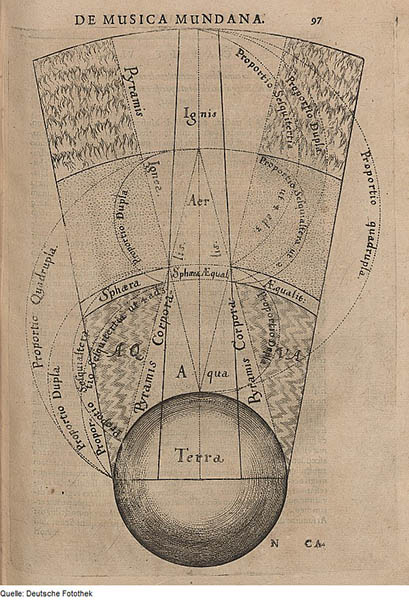In January, researchers from National Chung Cheng University in Taiwan and Alpen-Adria-Universität in Austria published a study in the journal Public Understanding of Science exploring the use of science words as lyrical elements in popular Taiwanese mainstream music. The intent of the study was to understand better how non-scientists were using science terminology in creating pop music songs, and perhaps learn something about bridging social contexts by exploring aspects of the most fundamental element of science communication: words.

De Musica Mundana, Robert Fludd, 1617. Courtesy of Deutsche Fotothek, public domain.
The study examined the content and quantity of scientific terms and expressions distributed throughout mainstream music lyrics as a potential reflection of the presence of science into Taiwanese popular culture and life. Starting with a list of 4526 songs created between 1990 and 2012 generated from the Golden Melody Awards, Asia’s mainstream music awards, the authors then reduced the sample based on the “relation of lyrics to science/technology” criterion. A total of 377 songs were ultimately selected for analysis by a panel of three researchers from the fields of science communication, communication, and popular culture. They examined the lyrics looking for scientific and technological terms, scientific metaphors, and/or expressions of scientific implications, and then categorized them as scientific activity or products, scientific research subjects, or cultural idioms. In those 377 songs, the researchers found 858 science words or phrases.
Terminology and expressions related to astronomy and space science tended to appear most prominently in the lyrics, followed by mentions of biology and genetics. An interesting caveat, however, offered by the authors about this finding is that because many of these lyrics are connected to expressions of emotional states and personal mood, they are only very rarely related to actual science or science issues. The research replicated an earlier study by Bucchi and Lorenzet (2008) of much older (1970-1990) Western popular music, which showed musicians favoring expressions of Darwin and evolution. As a result, the Taiwanese study’s authors suggest that music has an enduring potential to serve as a boundary object, providing shared meaning between the social worlds of science and everyday life as expressed in popular culture.
Bucchi and Lorenzet (2008) were the first to propose the idea of boundary objects as elements in the analysis of pop music’s role in science communication based on the concept introduced by science and technology Studies (STS) pioneers Star and Griesemer (1989). In the STS world, boundary objects are forms of information (words, images, real and graphical elements, as well as the things they build; sentences, reports, maps, and diagrams) whose structure is common enough to make them recognizable across more than one cultural or social world. The idea is that the items have a boundary status that gives them meaning and effect in both worlds. In the worlds of science and music, science terminology has meaning and effect in both realms.
This concept of music as a boundary object has intriguing and even instrumental implications for the public communication of science and examples of its uses abound. From Here Comes Science, an album by Grammy-nominated band They Might Be Giants, with songs about The Elements and the Sun, to the aging, but popular Barenaked Ladies’ The History of Everything for The Big Bang Theory television series, it seems that singing about science is increasingly popular. And if heartfelt science, but somewhat less professional singing is your thing, perhaps you need to witness the Large Hadron Rap. While these and other examples certainly show how it can be done, the question remains, does it have any long-term effect on the public understanding or appreciation of science?
Certainly the worlds of science and music will continue to share the use of terms of scientific activity and products, scientific research subjects, and cultural idioms of science. I wonder, however, what might be the effect of a concerted effort on the part of both parties to work toward the mutual benefit of science communication. I wonder if students singing of science in primary school might make the understanding of science easier in upper grades and in life. After all, the planets, like the wheels on the bus, also go round and round.
References
Bucchi, M. and Lorenzet A. (2008) Before and after science: Science and technology in pop music 1970–1990. In: Cheng D, Claessens M, Gascoigne NRJ, Metcalfe J, Schiele B and Shi S (eds) Communicating Science in Social Contexts: New Models, New Practices. Berlin: Springer, pp. 139–150.
Star, S. L. and Griesemer J. R. (1989) Institutional ecology, translations and boundary objects: Amateurs and professionals in Berkeley’s Museum of Vertebrate Zoology. Social Studies of Science 19: 387–420.

1 Trackback